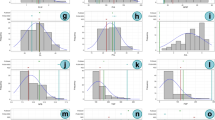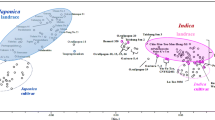Abstract
Weedy rice has been becoming a notorious weed in the paddy field of China in recent decades due to its increasing damage to rice yield and rice quality. In this study, a microsatellite technique with 21 pairs of SSR markers was utilized to estimate the genetic structure of two biotypes of weedy rice with Japonica and Indica rice characteristics, collected from Liaoning and Guangdong provinces, respectively. The genetic diversity of the weedy rice in the two provinces was relatively low (Liaoning h = 0.086; Guangdong h = 0.160), and distinctly large genetic differences existed between these two provinces (Gcs = 0.623). The genetic diversity was found primarily within populations, and genetic differentiation was relatively low within the same province. Both cluster analysis (UPGMA) and principle component analysis (PCA) showed that weedy rice had a closer relationship with the cultivated rice collected from the sample field than with other cultivated rice and common wild rice varieties in China. Thus, the results of this study on samples from the Liaoning and Guangdong provinces in China support the de-domestication hypothesis that weedy rice most probably originated from local cultivated rice.



Similar content being viewed by others

References
Bakar BB, Bakar MA, Man AB (2000) Weedy rice (Oryza sativa L.) in peninsular Malaysia. In: Baki BB, Chin DV, Mortimor M (eds) Wild and weedy rice in rice ecosystems in Asia—a review. IRRI, Los Banos, pp 51–54
Baker HG (1974) The evolution of weeds. Annu Rev Eco Syst 5:1–24
Cao QJ, Lu BR, Xia H, Rong J (2006) Genetic diversity and origin of weedy rice (Oryza sativa f. spontanea) populations found in northern-eastern China revealed by simple sequence repeat (SSR) markers. Ann Bot 98(6):1241–1252
Chen Y, Yang QW, Pan DJ, Li C (2008) Preliminary analysis of the Indica-Japonica differentiation among natural wild rice populations in Gaozhou by SSR markers. Mol Plant Breed 6:263–267
Cho YC, Chung TY, Suh HS (1995) Genetic characteristics of Korean weedy rice (Oryza sativa L.) by RFLP analysis. Euphytica 86:103–110
Ferrero A (2001) Biology and control of red rice (Oryza sativa L. var. sylvatica) infesting European fields. In: Chataigner J (ed) Medoryzae-interregional cooperative research network on rice in the Mediterranean climate. FAO-CIHEAM-institut Agronomique Mediterranneen, Montellie, pp 2–4
Ishikawa R, Toki N, Imai K, Sato YI, Yamagishi H, Shimamoto Y, Ueno K, Morishima H, Sato T (2005) Origin of weedy rice grown in Bhutan and the force of genetic diversity. Genet Resour Crop Evol 52:395–403
Jing W, Zhang WW, Jiang L, Chen LM, Zhai HQ, Wan JM (2007) Two novel loci for pollen sterility in hybrids between the weedy strain Ludao and the Japonica variety Akihikari of rice (Oryza sativa L.). Theor Appl Genet 11:915–925
Li YL, Yang XX, Zhao FP, Xu MH (2006) SSR markers on indica-japonica differentiation of natural population of Oryza rufipogon in Yuanjiang, Yunnan province. Chin J Rice Sci 20:137–140 (in Chinese)
Londo JP, Schaal BA (2007) Origins and population genetics of weedy rice in USA. Mol Ecol 16:4523–4535
Lu BR, Snow AA (2005) Gene flow from genetically modified rice and its environmental consequences. Bioscience 55(8):669–678 (in Chinese)
Lu YJ, Zheng KL (1992) A simple method for isolation of rice DNA. Chin J Rice Sci 6:47–48 (in Chinese)
Ma DR, Chen WF, Xu ZJ (2005) The investigation of weedy rices in Liaoning province. Liaoning Agric Sci 6:22–24 (in Chinese)
Mengistu LW, Christoffers MJ, Kegode GO (2004) Genetic diversity of biennial wormwood. Weed Sci 52:53–60
Nei M (1978) Estimation of average heterozygosity and genetic distance from a small number of individuals. Genetics 89:583–590
Ottis BV, Smith KL, Scott RC (2005) Rice yield and quality as affected by cultivar and red rice (Oryza sativa) density. Weed Sci 53:499–504
Panaud O, Chen X, McCouch SR (1996) Development of microsatellite markers and characterization of simple sequence length polymorphism (SSLP) in rice (Oryza sativa L.). Mol Gen Genet 252:597–607
Pantone DJ, Baker JB, Jordan PW (1992) Path analysis of red rice (Oryza sativa L.) competition with cultivated rice. Weed Sci 40:313–319
Rohlf FJ (1998) NTSYSpc: numerical taxonomy and multivariate analysis systerm, version 2.02. Setauket, New York
Suh HS, Sato YI, Morishima H (1997) Genetic characterization of weedy rice (Oryza sativa L.) based on morpho-physiology, isozymes and RAPD markers. Theor Appl Genet 94:316–321
Tang LH, Morishima H (1988) Characteristics of weed rice strains. Rice Genet Newslett 5:70–72
Wang ZS (1996) The genetic diversity of Chinese common wild rice (Oryza rufipogon) and cultivated rice detected by molecular markars. PhD dissertation, Beijing, China: Chinese Agricultural University (in Chinese)
Xu C, Wu WC (1996) Ecological investigating and identifying of weedy rices in Hainan Island. Chin J Rice Sci 10:247–249 (in Chinese)
Yeh F, Yang R, Boyle T (1999) Microsoft window-based freeware for population genetic analysis (POPGENE), version 1.31
You XL (1990) The discussion of wild rices recorded in the Chinese ancient works. In Wu MS (eds) The symposium of wild rice resource research. Chinese Science and Technology Press, Beijing, China, pp 174–180 (in Chinese)
Yu GQ, Bao Y, Ge S (2005) Genetic diversity and population differentiation of Liaoning weedy rice detected by RAPD and SSR markers. Biochem Genet 43:261–270
Zhong WG, Yang J, Chen ZD (2006) Classification of weedy rice in Yangzhong City of Jiangsu province. Jiangsu J Agric Sci 22:238–242 (in Chinese)
Zhu SS, Jiang L, Wang CM, Zhai HQ, Li DT, Wan JM (2005) The origin of weedy rice Ludao in China deduced by genome wide analysis of its hybrid sterility genes. Breed Sci 55:409–414
Acknowledgments
This project was financially supported by National Basic Research and Development Program (2007CB109202), China Transgenic Organism Research and Commercialization Project (No. 2008ZX08011), (2009ZX08012-020B), the National Natural Science Foundation of China (Grant No. 30800604) and Jiangsu Postdoctoral Foundation (Grant No. 0701040B). We appreciate National wild rice Germplasm Garden in Nanning, Guangxi for the wild rice accessions they offered. The authors also gratefully acknowledge Li Shushun for his excellent technical assistance.
Author information
Authors and Affiliations
Corresponding author
Additional information
Lianju Zhang and Weimin Dai contributed equally to this work.
Rights and permissions
About this article
Cite this article
Zhang, L., Dai, W., Wu, C. et al. Genetic diversity and origin of Japonica- and Indica-like rice biotypes of weedy rice in the Guangdong and Liaoning provinces of China. Genet Resour Crop Evol 59, 399–410 (2012). https://doi.org/10.1007/s10722-011-9690-9
Received:
Accepted:
Published:
Issue Date:
DOI: https://doi.org/10.1007/s10722-011-9690-9



